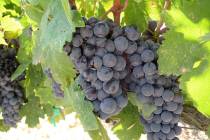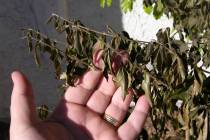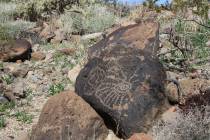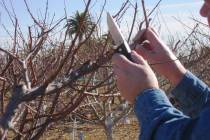Q: I purchased a few waxleaf privet plants in February. They were planted in my yard using drip irrigation with one drip emitter per plant for about one month now. I am starting to see some black markings and yellowing on the leaves. I also think there may be some root rot, but I am unsure.
Local Columns
If you have fruit trees, the next big tree management activity you are facing is fruit thinning or removing excessive amounts of fruit so that the remaining fruit gets larger. Peaches, nectarines, plums, apples and pears must have excessive fruit removed if you want larger fruit. Do this as soon as the fruit reaches the size of your thumbnail.
Seeing Arizona’s Grand Canyon is either on your bucket list already or ought to be.
Q: What do you recommend for controlling that ugly, leaf-footed bug that attacks my pomegranates? I want to be prepared.
Q: Peaches from my dwarf peach tree were very small again last year. This is the third year the fruit developed into a small size. We fertilize them twice a year with vegetable spikes and our in-ground system fertilizer system has Dr. Benson’s Natural Mix added five times per year. Any suggestions?
Zion National Park is a spectacular destination year-round, but spring is one of the best times to visit.
Q: I have some tomatoes and pepper plants in pots. They are about 18 inches tall. Is it too early to plant them in my raised bed garden? It’s been too cold lately to plant.
Q: I am from San Miguel Community Garden, a nonprofit garden located near the North Las Vegas Airport. We are considering adding more grape plants to the garden. We have Flaming Red and Thompson grapes. You said you have grown many different varieties in the Las Vegas Valley, and I was wondering if you would share with me other varieties that were successful for you so we can explore them as well.
The park located just outside of Twentynine Palms, California, encompasses almost 800,000 acres, with elevations ranging from 536 feet to 5,814 feet.
Many people contacted me about whether they could plant seeds or put transplants into the ground because of this unusually cold weather. My answer was the same to them as it is here. It depends.
Q: I want to propagate my prickly pear and bunny ear cactus. Should I place the cuttings immediately in the ground or in a pot and plant them in the ground later?
The hike from Zabriskie Point to Golden Canyon is a moderately strenuous one, but it rewards the strong with a look at some of Death Valley National Park’s finest geologic formations.
Another freeze went through the valley this past week along with some unusually cold weather. Freezing temperatures are more damaging to plants as we enter the spring months because plants are starting to wake up from their winter dormant period. These same plants might have no problems with these temperatures in December and January.
Can an old, neglected grapevine be revived? Horticulture expert Bob Morris answers that question and more.
This former U.S. Army station from the 1860s sits just outside Nevada’s southern tip.
Maybe gardeners aren’t busy in Minnesota or Iowa during the winter, but for gardeners living in the Mojave Desert, it is probably our busiest time of year. I’m asked about spraying dormant oils on trees, but most people don’t know anything about them. It’s a shame because it’s probably the most important method to control bugs that may become problems during the coming year. It’s good insurance.
Q: I planted a Bosc pear tree seven years ago not realizing it required a second pollenizer pear tree. For several years, I did get a few pears even though the tree had lots of flowers. I think my neighbor’s pear tree was the pollenizer, but it seems to be failing. I have no room to plant a pollenizer pear tree. Not sure what to do.



















